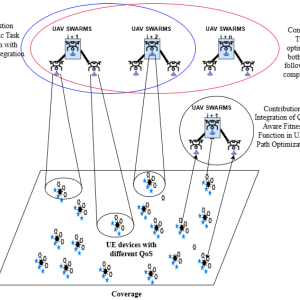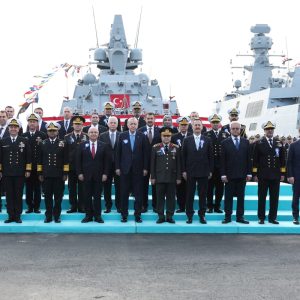The integration of advancing autonomy in naval aviation has become a focal point for defense strategies worldwide. As a leader in cutting-edge military innovation, we are proud to collaborate with Shield AI, a trailblazer in artificial intelligence and autonomous systems. This partnership is not merely a strategic alliance; it is a bold step toward redefining the future of naval aviation. These combined efforts are set to revolutionize how naval forces operate, ensuring superiority and readiness in the face of emerging threats.

The Strategic Importance of Autonomy in Naval Operations
Autonomous technology represents a paradigm shift in naval operations. Traditional manned aircraft, while highly effective, are limited by human endurance, reaction time, and the inherent risks of putting personnel in harm’s way. The introduction of unmanned aerial vehicles (UAVs) and autonomous systems mitigates these limitations, offering enhanced operational capabilities that are crucial in modern warfare. By leveraging AI-driven technologies, autonomous systems can process vast amounts of data in real-time, make split-second decisions, and execute missions with a precision that surpasses human capability.
The strategic importance of integrating autonomous systems into naval aviation cannot be overstated. These technologies provide a force multiplier effect, enabling naval forces to conduct persistent surveillance, reconnaissance, and combat operations with minimal risk. Moreover, autonomous systems offer the flexibility to operate in environments that would be otherwise inaccessible or too dangerous for manned aircraft, such as contested airspace or areas affected by nuclear, biological, or chemical threats.
Shield AI: A Leader in Autonomous Systems
Shield AI is at the forefront of developing advanced AI-powered technologies designed to enhance the autonomy of military operations. Their flagship product, the Hivemind autonomous software, is a cutting-edge solution that enables UAVs to operate independently in complex and dynamic environments. Hivemind leverages deep learning algorithms to interpret sensor data, recognize objects, and navigate autonomously without relying on GPS or external communications. This level of autonomy is crucial for operating in contested environments where GPS signals may be jammed or communications disrupted.
This collaboration with Shield AI brings together this deep expertise in naval aviation and their pioneering advancements in AI technology. This partnership is poised to deliver a new generation of autonomous systems that will redefine the operational capabilities of naval forces.
Enhancing Situational Awareness with Autonomous Systems
One of the primary benefits of integrating autonomous systems into naval aviation is the enhancement of situational awareness. In a battlefield scenario, real-time situational awareness is critical for making informed decisions and executing missions effectively. Autonomous UAVs equipped with advanced sensors and AI-driven analytics can provide a comprehensive view of the battlespace, detecting threats and relaying crucial information to command centers.
Autonomous systems are capable of operating in a swarm configuration, where multiple UAVs work in tandem to cover large areas, identify targets, and relay information back to operators. This capability not only enhances situational awareness but also increases the likelihood of mission success by ensuring that decision-makers have access to the most accurate and up-to-date information.
Furthermore, autonomous systems can be deployed in a wide range of mission profiles, from intelligence, surveillance, and reconnaissance (ISR) missions to electronic warfare and strike operations. By reducing the cognitive load on human operators, these systems allow for more efficient and effective mission planning and execution.
Operational Flexibility and Mission Endurance
The integration of autonomous systems into naval aviation extends the operational flexibility and endurance of naval forces. Traditional manned aircraft are constrained by the physical and psychological limitations of human pilots. Autonomous UAVs, on the other hand, can operate for extended periods without the need for rest, enabling continuous operations in critical mission areas.
Autonomous systems also offer the flexibility to operate in environments that are too dangerous or inhospitable for manned aircraft. For example, UAVs can be deployed in anti-access/area denial (A2/AD) environments, where enemy defenses are designed to prevent access to specific areas. By operating autonomously, these systems can navigate through contested airspace, identify and engage threats, and return valuable intelligence without putting human lives at risk.
Moreover, autonomous systems can be programmed to perform a wide range of missions, from routine patrols to high-risk combat operations. This versatility makes them an invaluable asset to naval forces, providing the capability to respond to emerging threats quickly and effectively.
Force Multiplication and Resource Optimization
In an era of constrained defense budgets and increasing operational demands, resource optimization is critical for maintaining military readiness. Autonomous systems offer a force multiplication effect, enabling naval forces to achieve greater operational outcomes with fewer resources. By automating routine tasks and missions, autonomous UAVs free up human operators to focus on higher-priority objectives, maximizing the efficiency of military operations.
Additionally, autonomous systems reduce the logistical burden associated with deploying and maintaining manned aircraft. UAVs can be launched and recovered from a variety of platforms, including aircraft carriers, destroyers, and submarines, without the need for extensive infrastructure or personnel. This capability not only reduces the operational footprint of naval forces but also increases their ability to project power in remote and contested regions.
The cost-effectiveness of autonomous systems is another significant advantage. While the initial investment in autonomous technology may be substantial, the long-term savings in operational and maintenance costs are considerable. UAVs require less maintenance than manned aircraft, have lower fuel consumption, and can be produced at a fraction of the cost. These factors make autonomous systems a cost-effective solution for enhancing the operational capabilities of naval forces.
Addressing Challenges in Autonomous Naval Aviation
While the benefits of autonomous systems in naval aviation are clear, there are also significant challenges that must be addressed to fully realize their potential. One of the primary challenges is the development of reliable and secure communication links between autonomous systems and human operators. In a contested environment, communication links are vulnerable to jamming, interception, and cyber-attacks, which could compromise the effectiveness of autonomous systems.
To address this challenge, this partnership with Shield AI focuses on developing robust communication protocols that ensure secure and reliable data transmission. This includes the use of encrypted communications, frequency hopping, and the integration of advanced cybersecurity measures to protect against cyber threats. By ensuring that autonomous systems can operate effectively in contested environments, we are enhancing the resilience and reliability of naval aviation operations.
Another challenge is the ethical and legal implications of using autonomous systems in combat. The use of AI-driven systems raises important questions about accountability, decision-making, and the rules of engagement. To address these concerns, we are working closely with legal and ethical experts to develop guidelines and protocols that ensure the responsible use of autonomous systems in military operations. This includes establishing clear lines of accountability, defining the roles and responsibilities of human operators, and ensuring compliance with international laws and norms.
Future Prospects: The Evolution of Autonomous Naval Aviation
The integration of autonomous systems into naval aviation is not just a trend; it is the future of military operations. As technology continues to evolve, we can expect to see even greater levels of autonomy and capability in UAVs and other autonomous platforms. The development of next-generation AI and machine learning algorithms will enable autonomous systems to perform increasingly complex tasks, from real-time threat analysis to autonomous decision-making in combat scenarios.
In the future, autonomous systems may be capable of conducting entire missions without human intervention, from planning and execution to post-mission analysis. This level of autonomy would not only enhance the operational capabilities of naval forces but also reduce the risks associated with human error and decision fatigue.
The future of autonomous naval aviation also includes the integration of man-machine teaming, where autonomous systems work alongside human operators to achieve mission objectives. This approach leverages the strengths of both humans and machine, combining the creativity and adaptability of human operators with the speed and precision of autonomous systems. Man-machine teaming is expected to play a critical role in future naval operations, enabling naval forces to respond to emerging threats with unprecedented speed and agility.
Conclusion
This partnership with Shield AI represents a significant milestone in the evolution of naval aviation. By integrating advanced autonomous systems into these operations, we enhance naval forces’ situational awareness, operational flexibility, and mission endurance. These capabilities are crucial for maintaining superiority in an increasingly complex and contested security environment.
As we continue to develop and refine autonomous technologies, we are committed to addressing the challenges associated with their use, including communication security, ethical considerations, and legal implications. Through this commitment, we are ensuring that autonomous systems are used responsibly and effectively to defend the nation and its allies.
The future of naval aviation is autonomous. With the combined expertise of this organization and Shield AI, we are leading the way in developing the next generation of autonomous systems that will redefine the operational capabilities of naval forces. This is not just an evolution in technology; it is a revolution in how naval forces operate, ensuring that we remain at the forefront of military innovation and readiness for years to come.
The Role of Autonomous Systems in Modern Warfare
In modern warfare, the ability to adapt to rapidly changing threats is paramount. Autonomous systems provide naval forces with the agility and responsiveness needed to stay ahead of adversaries. These systems can be rapidly deployed, reconfigured for different mission profiles, and operated with minimal logistical support, making them an ideal solution for modern military operations.
One of the key roles of autonomous systems in modern warfare is force protection. UAVs equipped with advanced sensors and weapons can be deployed to monitor and defend naval assets from threats, such as enemy aircraft, missiles, and surface vessels. By providing an additional layer of defense, autonomous systems enhance the survivability of naval forces in hostile environments.
The future of naval aviation is autonomous, and with our partnership with Shield AI, we are leading the way in developing the next generation of autonomous systems that will redefine the operational capabilities of naval forces. This is not just an evolution in technology; it is a revolution in how naval forces operate, ensuring that we remain at the forefront of military innovation and readiness for years to come.










